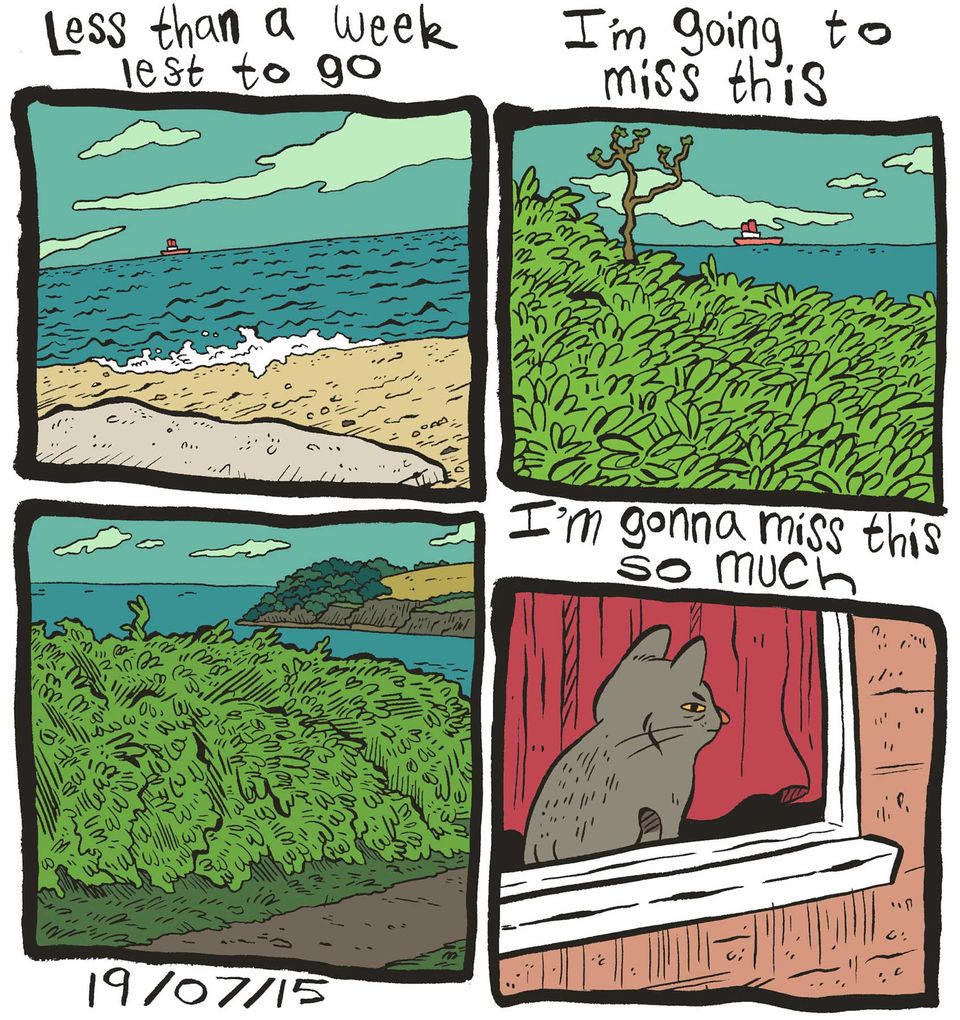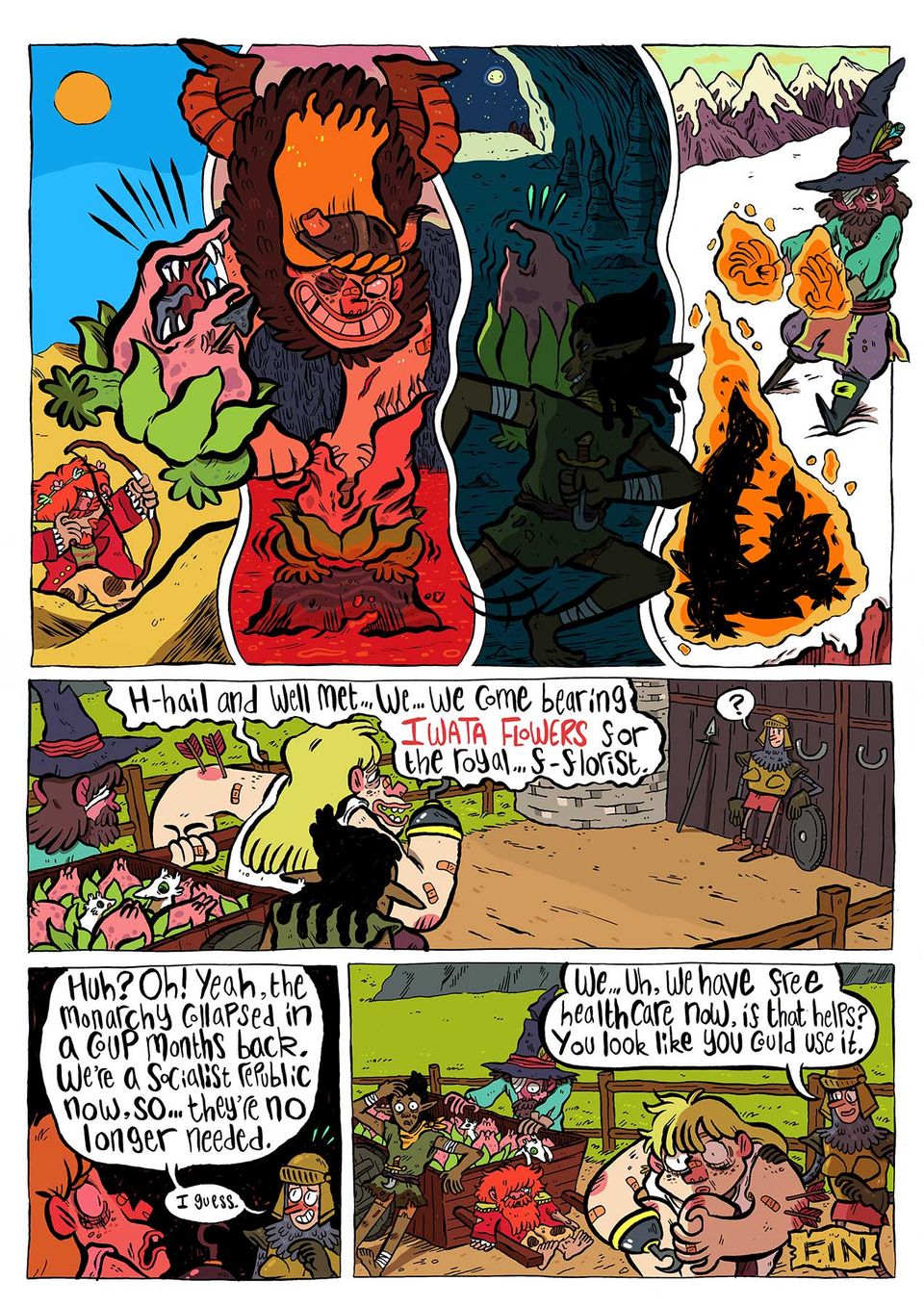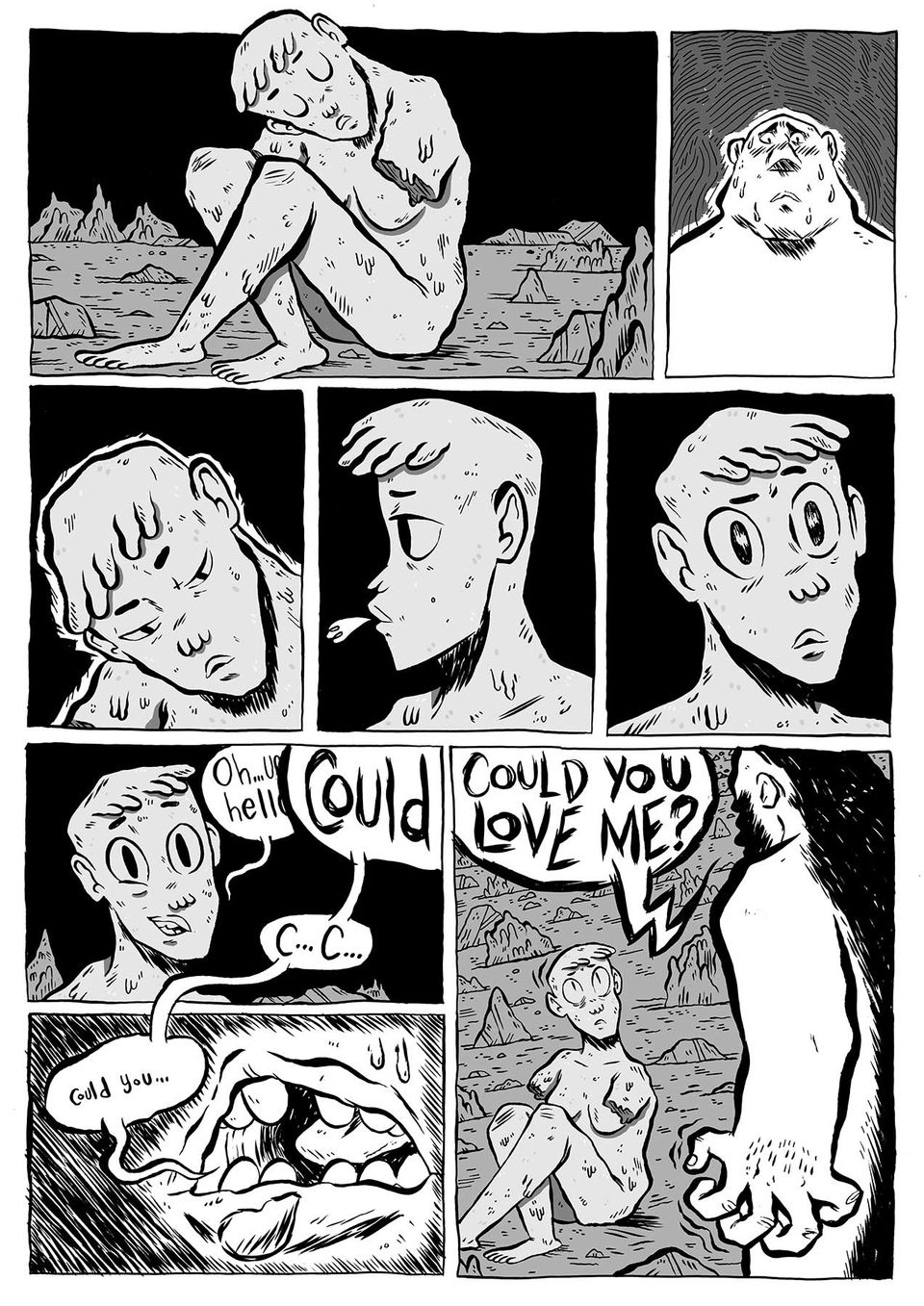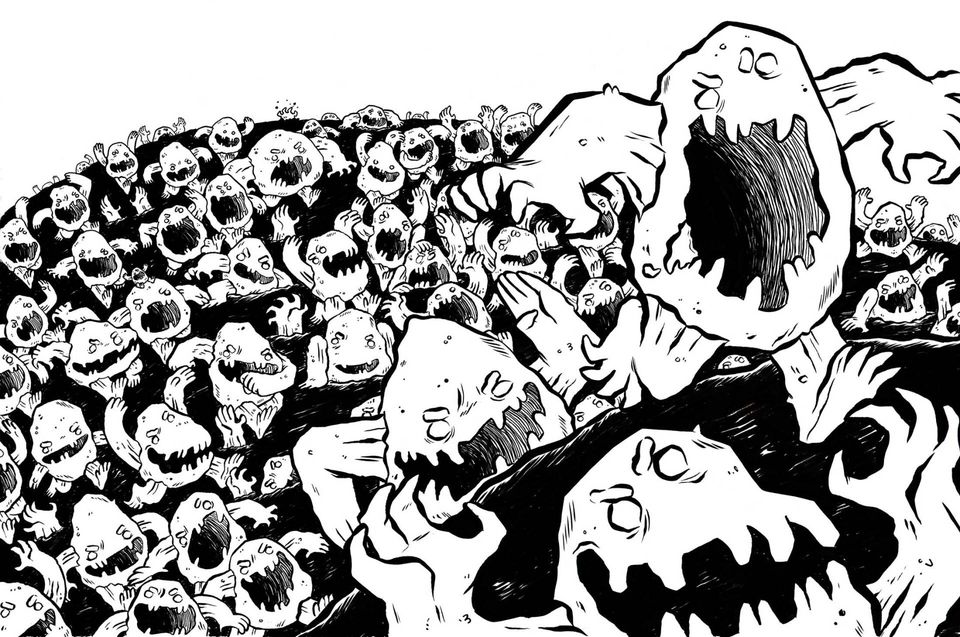Artist Spotlight: Lucie Ebrey
Website Editor • September 5, 2019
Everyone’s work is deeply idiosyncratic: in our regular Spotlight segment we explore artists’ experiences and inspiration to understand what defines and inspires their unique styles.
Can you give us a brief background on yourself?
It's a really stock answer, but like most people working in the arts, it was really just a case of never stopping drawing. I devoured so many cartoons and comics as a kid, and was still really interested in them through my teen years. I knew it was something I wanted to pursue, but I was so weighed down with GCSE's and A Levels that it wasn't until I'd finally finished my foundation course that I was actively drawing cartoons regularly again. I started drawing a comic diary every day. I went to Falmouth University, after literally years of setting my sights on it, and graduated in 2015.
Now I'm working freelance and juggling as much as I can without collapsing in a pile of bristol board and tears! It's really scary and I'm always having to learn something new, but I'm already surprised with what I've ended up creating.

What kind of influence does your location have on your career?
Currently, I'm working from home in Birmingham. I've lived in this city my whole life and as much as I am fond of it, I admit I'm frustrated with the lack of any real art scene that I'd want to be a part of. It's all very experimental fine art and there's no real opportunities that I could apply my skills to here either (something that became depressingly clear in the post-uni-CV-emailing flurry). I'm lucky that my career allows me to accept work from clients who aren't even in the same country as I am! As long as I have working internet and a decent scanner, then I'm pretty much good to go. I'd love to move to somewhere with a more thriving art scene sometime in the future, but I think every 20-something ex-art student is looking for that haha. I feel like my location is pretty incidental when it comes to how it directly influences my work, although it probably comes out strongest in my comic diaries. Especially towards the end of my stay down in Cornwall when I had strips dedicated to the coastline and sentimental memories of 3 life-changing years.
What is your greatest source of inspiration?
I often find my greatest inspiration comes from the mundane everyday of human behaviours, and those little moments that might mean something but probably mean nothing. It comes with the territory when you have to draw a comic strip about that sort of thing every day. On the other hand, I love cooking up bombastic and ridiculous tales from the more fantastical ideas in my head that come from watching a lot of movies or playing too many video games. I try to avoid being boxed into any specific genre or type of work, especially this early on in my career, and tend to just lean into whatever feels right in the moment. In terms of other artists who have influenced me, I have so many in so many different mediums that it's hard to narrow the list down to only a few core people, but a couple of names do stand out to me. The most obvious one, I suppose, would be James Kochalka - a cartoonist from Vermont. For 14 years he drew a daily diary comic called American Elf, and after coming across it when I was around 18, I instantly wanted to see if I could do it too! I began my own in May 2012 and I'm still going to this day. I owe Kochalka a lot. In terms of other creators whose work I know for sure changed my view and approach of cartooning, the list includes folks like Matt Groening, Art Spiegelman, Craig Thompson, Marjane Satrapi, Chuck Jones, Hayao Miyazaki, Luke Pearson, Jack Teagle, Will Eisner, and honestly too many to list here without it dragging on and on.
Could you pick one piece of art that has made a lasting influence on you, and if so why?
Again, there's so many that struck a chord with me for some specific reason or another that elevating one to becoming the most significant is very hard. But the one that's jumping out to me right now would be Maus by Art Spiegelman.
I first encountered it when I was 13 at my local library, and it was the first ever graphic novel I ever read that was about more than superheroes. To be honest, I found it incredibly shocking at that age, since it's about Spiegelman's father struggling as a Polish Jew during WWII and certainly doesn't shy away from the most harrowing aspects of the Holocaust. Even though it was profoundly upsetting to me at the time, I was also incredibly excited by it. I was floored at how not only was it using comics as a way of telling a mature story, but it was also using animals in such a symbolic way. The idea of making the Jews mice, the Germans cats, and the Poles pigs seems almost reductive at a first glance, but is actually a brilliant way of illustrating the lack of humanity shown within the pages. I'd never encountered a piece of media that was so layered and well executed at that point, and I still hold it in high regard to this day. It was the gateway graphic novel that nudged me towards where I am today.
What skills or techniques do you find most useful in your line of work? Do you use primarily traditional or digital methods to create your artwork?
The most useful skill is simply to be efficient and work to a schedule. The second I slack off and don't adhere to it is when things become instantly more stressful, and I'm getting better at it as time goes on. It's especially important with regards to keeping up with my daily comic diaries, as a single day where I decide I can't be bothered to ink the strip can cause a serious pileup later on down the road. As for how I approach my work, I'm a mix of both traditional and digital. I ink almost exclusively with a brush pen of some kind on to paper, which I then scan in and colour digitally in Photoshop. I love the tactile sensation of dragging a brush across paper and the infinite possibilities when colouring in a digital space, so it's the ideal set-up for me! I will also dabble in water colours and pottery ever so often to have a rest, and also to try something new. It's a good way to get the artistic juices flowing if ink or Photoshop is getting stale. Plus I end up with stuff that I can give to friends or put a new plant in, and that's just great.
How can people who are interested in discovering more of your work find it?
My website is at www.lucieebrey.com,
or you can follow my Tumblr where my almost-5 year long daily diary comic gets added to regularly at www.muggyebes.tumblr.com.
Then there's my Twitter @LucieEbrey
and my Instagram @lucie_ebrey.
Scriba is a revolutionary digital stylus that is ergonomically designed to comfortably fit your hand and uses unique Squeeze-Motion technology. Order here.
Articles

The United Nations has described the disruption to education caused by the pandemic as ‘unparalleled’. At the virus’ worldwide peak in April, it is estimated that over 90% of all enrolled learners, from kindergarten to bachelors and beyond, had their education affected by school closures and the pandemic (UNESCO). For many university students and older children, they have had to adapt quickly to online learning. They can keep in touch with their peers and teachers online and continue their studies, albeit in a highly modified way. As challenging as this may be, this experience will help equip them for a future that is increasingly online. For parents of younger children, they are assuming a new role: their child’s home school teacher. This is in addition to their usual childcare and household duties, their work responsibilities and often emotional and financial worries caused by the pandemic. Stressful? Yes. The good, and somewhat surprising, news? The experts advise that you don’t teach your children - at least not in the way you might expect.

If the recent outbreak of Covid-19 has taught us anything, it's that many adults do not wash their hands effectively. It has never been more important that we support our children to develop good personal hygiene to keep themselves and our families safe. This seemingly easy task can be very difficult for children with fine motor skill difficulties. In this article, we explore some ideas to support your child with hand washing.

Lockdown has brought the digital future into the now. Online shopping, entertainment, education and more have moved from the periphery to the mainstream to, in many cases, the only option. With the necessity of social distancing looking to continue for many months, it appears that this rapid digital revolution is here to stay. This means that life as we know it, in most of its sectors, has changed forever. In order to survive, businesses are having to adapt rapidly, embrace technology and look to the future. Architecture is no exception. There has been a widespread adoption of technology and VR over the past few months in response to the lockdown across all of society. Elderly grandparents who were once resistant to adopt new technologies talk of “Zooming” and have started video chatting with their family members to combat loneliness. Art galleries that were once considered stuffy or pretentious are now pioneers in VR technology, with Google Art & Culture offering tours of London’s National Gallery or the Musee D’Orsay in Paris. These virtual tours deliver art in a dynamic new way that can be far more engaging than regular photos. Critics have applauded the panoramic and immersive views of gallery building and exhibitions which work well for rendering of 2 dimensional art, however impressions of sculpture is somewhat lacklustre. With VR technology, users can enjoy a truly immersive experience in the comforts, and safety, of their own home. The COVID-19 pandemic has served as an accelerant for the arts and entertainment industries to embrace VR.






